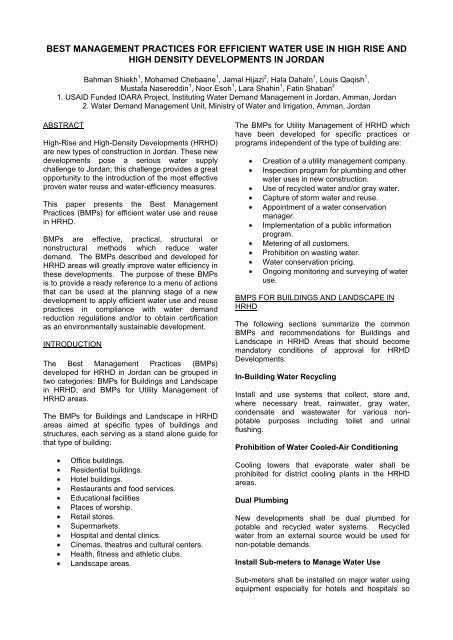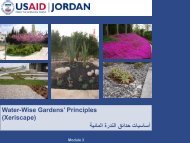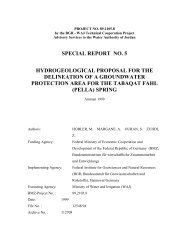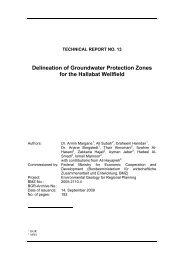best management practices for efficient water use in high rise and ...
best management practices for efficient water use in high rise and ...
best management practices for efficient water use in high rise and ...
Create successful ePaper yourself
Turn your PDF publications into a flip-book with our unique Google optimized e-Paper software.
BEST MANAGEMENT PRACTICES FOR EFFICIENT WATER USE IN HIGH RISE AND<br />
HIGH DENSITY DEVELOPMENTS IN JORDAN<br />
Bahman Shiekh 1 , Mohamed Chebaane 1 , Jamal Hijazi 2 , Hala Dahaln 1 , Louis Qaqish 1 ,<br />
Mustafa Naseredd<strong>in</strong> 1 , Noor Esoh 1 , Lara Shah<strong>in</strong> 1 , Fat<strong>in</strong> Shaban 2<br />
1. USAID Funded IDARA Project, Institut<strong>in</strong>g Water Dem<strong>and</strong> Management <strong>in</strong> Jordan, Amman, Jordan<br />
2. Water Dem<strong>and</strong> Management Unit, M<strong>in</strong>istry of Water <strong>and</strong> Irrigation, Amman, Jordan<br />
ABSTRACT<br />
High-Rise <strong>and</strong> High-Density Developments (HRHD)<br />
are new types of construction <strong>in</strong> Jordan. These new<br />
developments pose a serious <strong>water</strong> supply<br />
challenge to Jordan; this challenge provides a great<br />
opportunity to the <strong>in</strong>troduction of the most effective<br />
proven <strong>water</strong> re<strong>use</strong> <strong>and</strong> <strong>water</strong>-efficiency measures.<br />
This paper presents the Best Management<br />
Practices (BMPs) <strong>for</strong> <strong>efficient</strong> <strong>water</strong> <strong>use</strong> <strong>and</strong> re<strong>use</strong><br />
<strong>in</strong> HRHD.<br />
BMPs are effective, practical, structural or<br />
nonstructural methods which reduce <strong>water</strong><br />
dem<strong>and</strong>. The BMPs described <strong>and</strong> developed <strong>for</strong><br />
HRHD areas will greatly improve <strong>water</strong> efficiency <strong>in</strong><br />
these developments. The purpose of these BMPs<br />
is to provide a ready reference to a menu of actions<br />
that can be <strong>use</strong>d at the plann<strong>in</strong>g stage of a new<br />
development to apply <strong>efficient</strong> <strong>water</strong> <strong>use</strong> <strong>and</strong> re<strong>use</strong><br />
<strong>practices</strong> <strong>in</strong> compliance with <strong>water</strong> dem<strong>and</strong><br />
reduction regulations <strong>and</strong>/or to obta<strong>in</strong> certification<br />
as an environmentally susta<strong>in</strong>able development.<br />
INTRODUCTION<br />
The Best Management Practices (BMPs)<br />
developed <strong>for</strong> HRHD <strong>in</strong> Jordan can be grouped <strong>in</strong><br />
two categories: BMPs <strong>for</strong> Build<strong>in</strong>gs <strong>and</strong> L<strong>and</strong>scape<br />
<strong>in</strong> HRHD, <strong>and</strong> BMPs <strong>for</strong> Utility Management of<br />
HRHD areas.<br />
The BMPs <strong>for</strong> Build<strong>in</strong>gs <strong>and</strong> L<strong>and</strong>scape <strong>in</strong> HRHD<br />
areas aimed at specific types of build<strong>in</strong>gs <strong>and</strong><br />
structures, each serv<strong>in</strong>g as a st<strong>and</strong> alone guide <strong>for</strong><br />
that type of build<strong>in</strong>g:<br />
Office build<strong>in</strong>gs.<br />
Residential build<strong>in</strong>gs.<br />
Hotel build<strong>in</strong>gs.<br />
Restaurants <strong>and</strong> food services.<br />
Educational facilities<br />
Places of worship.<br />
Retail stores.<br />
Supermarkets.<br />
Hospital <strong>and</strong> dental cl<strong>in</strong>ics.<br />
C<strong>in</strong>emas, theatres <strong>and</strong> cultural centers.<br />
Health, fitness <strong>and</strong> athletic clubs.<br />
L<strong>and</strong>scape areas.<br />
The BMPs <strong>for</strong> Utility Management of HRHD which<br />
have been developed <strong>for</strong> specific <strong>practices</strong> or<br />
programs <strong>in</strong>dependent of the type of build<strong>in</strong>g are:<br />
Creation of a utility <strong>management</strong> company.<br />
Inspection program <strong>for</strong> plumb<strong>in</strong>g <strong>and</strong> other<br />
<strong>water</strong> <strong>use</strong>s <strong>in</strong> new construction.<br />
Use of recycled <strong>water</strong> <strong>and</strong>/or gray <strong>water</strong>.<br />
Capture of storm <strong>water</strong> <strong>and</strong> re<strong>use</strong>.<br />
Appo<strong>in</strong>tment of a <strong>water</strong> conservation<br />
manager.<br />
Implementation of a public <strong>in</strong><strong>for</strong>mation<br />
program.<br />
Meter<strong>in</strong>g of all customers.<br />
Prohibition on wast<strong>in</strong>g <strong>water</strong>.<br />
Water conservation pric<strong>in</strong>g.<br />
Ongo<strong>in</strong>g monitor<strong>in</strong>g <strong>and</strong> survey<strong>in</strong>g of <strong>water</strong><br />
<strong>use</strong>.<br />
BMPS FOR BUILDINGS AND LANDSCAPE IN<br />
HRHD<br />
The follow<strong>in</strong>g sections summarize the common<br />
BMPs <strong>and</strong> recommendations <strong>for</strong> Build<strong>in</strong>gs <strong>and</strong><br />
L<strong>and</strong>scape <strong>in</strong> HRHD Areas that should become<br />
m<strong>and</strong>atory conditions of approval <strong>for</strong> HRHD<br />
Developments.<br />
In-Build<strong>in</strong>g Water Recycl<strong>in</strong>g<br />
Install <strong>and</strong> <strong>use</strong> systems that collect, store <strong>and</strong>,<br />
where necessary treat, ra<strong>in</strong><strong>water</strong>, gray <strong>water</strong>,<br />
condensate <strong>and</strong> waste<strong>water</strong> <strong>for</strong> various nonpotable<br />
purposes <strong>in</strong>clud<strong>in</strong>g toilet <strong>and</strong> ur<strong>in</strong>al<br />
flush<strong>in</strong>g.<br />
Prohibition of Water Cooled-Air Condition<strong>in</strong>g<br />
Cool<strong>in</strong>g towers that evaporate <strong>water</strong> shall be<br />
prohibited <strong>for</strong> district cool<strong>in</strong>g plants <strong>in</strong> the HRHD<br />
areas.<br />
Dual Plumb<strong>in</strong>g<br />
New developments shall be dual plumbed <strong>for</strong><br />
potable <strong>and</strong> recycled <strong>water</strong> systems. Recycled<br />
<strong>water</strong> from an external source would be <strong>use</strong>d <strong>for</strong><br />
non-potable dem<strong>and</strong>s.<br />
Install Sub-meters to Manage Water Use<br />
Sub-meters shall be <strong>in</strong>stalled on major <strong>water</strong> us<strong>in</strong>g<br />
equipment especially <strong>for</strong> hotels <strong>and</strong> hospitals so
<strong>water</strong> <strong>use</strong> <strong>for</strong> that area or process can be<br />
monitored <strong>and</strong> leaks <strong>and</strong> other malfunctions may<br />
be identified. Submeter locations will <strong>in</strong>clude:<br />
Laundry operations<br />
Swimm<strong>in</strong>g pools <strong>and</strong> spas<br />
Food service & kitchens<br />
Irrigation systems<br />
Separate <strong>water</strong> heat<strong>in</strong>g systems<br />
Makeup/feed <strong>water</strong> <strong>for</strong> blowdown <strong>water</strong><br />
from cool<strong>in</strong>g towers <strong>and</strong> boilers<br />
Condensate return l<strong>in</strong>es to boilers<br />
Kidney dialysis <strong>water</strong> treatment systems<br />
Water treatment system <strong>and</strong> <strong>for</strong> the reject<br />
<strong>water</strong><br />
Other types of <strong>water</strong> us<strong>in</strong>g equipment or<br />
process that consumes <strong>water</strong><br />
Records <strong>for</strong> <strong>water</strong> <strong>use</strong> shall be ma<strong>in</strong>ta<strong>in</strong>ed to<br />
monitor <strong>water</strong> <strong>use</strong> on a daily basis <strong>and</strong> to identify<br />
any <strong>water</strong> waste that is tak<strong>in</strong>g place.<br />
Control Maximum Pressure with<strong>in</strong> Build<strong>in</strong>gs<br />
When static <strong>water</strong> pressure <strong>in</strong> a build<strong>in</strong>g exceeds<br />
3.0 bars (43.5 psi), an approved type of pressure<br />
regulator <strong>and</strong> pressure relief valve shall be <strong>in</strong>stalled<br />
<strong>and</strong> properly ma<strong>in</strong>ta<strong>in</strong>ed by the customer so that<br />
the <strong>water</strong> pressure is reduced to 3.0 bars (43.5 psi)<br />
or less.<br />
Plumb<strong>in</strong>g Fixtures<br />
Toilets shall be dual flush models with a<br />
maximum average flush volume of 6/3 liters per<br />
flush).<br />
Pressure assist toilets shall have a maximum<br />
flush volume of 4.8 liters (1.3 Gallon) per flush.<br />
S<strong>in</strong>gle flush toilets with a maximum flush volume<br />
of 4.8 liters per flush.<br />
Ur<strong>in</strong>als shall have a maximum flow rate of 1.9<br />
liters/flush, (0.5 Gallon per flush) or shall be zero<br />
<strong>water</strong> consumption ur<strong>in</strong>als.<br />
Showerheads shall have a maximum rated flow<br />
of 7.6 liters per m<strong>in</strong>ute (2 GPM) at 3 bars.<br />
Self clos<strong>in</strong>g faucets with preset flow times shall<br />
be <strong>in</strong>stalled on lavatories <strong>in</strong>tended to serve the<br />
transient public <strong>and</strong> shall deliver not more than<br />
1.0 liters (0.26 Gallons) of <strong>water</strong> per <strong>use</strong>.<br />
Maximum flow rate <strong>and</strong> consumption of notmetered<br />
faucets <strong>for</strong> public lavatory shall not<br />
exceed 4.5 liters/m<strong>in</strong> (1.19 GPM) at 3 bars.<br />
Faucets <strong>for</strong> homes <strong>and</strong> hotel guest rooms shall<br />
not exceed a flow of 4.5 liters/m<strong>in</strong> at 3 bars.<br />
Residential kitchen faucets shall not exceed a<br />
maximum rated flow of 9.0 liters/m<strong>in</strong> (2.38 GPM)<br />
at 3.0 bars.<br />
Residential Appliances<br />
Dishwashers shall <strong>use</strong> less than 24 liters (6.3<br />
Gallons) per load (St<strong>and</strong>ard) <strong>and</strong> 16.7 liters (4.4<br />
Gallons) per load (Compact).<br />
Food Service Equipment<br />
Commercial kitchen h<strong>and</strong> wash<strong>in</strong>g faucets shall<br />
not exceed 4.5 liters per m<strong>in</strong>ute.<br />
Ice mak<strong>in</strong>g mach<strong>in</strong>es shall be air-cooled,<br />
Water-cooled ice mach<strong>in</strong>e are prohibited.<br />
Commercial refrigeration shall be air-cooled, or<br />
if <strong>water</strong>-cooled, shall have a closed looped<br />
system. No once-through, s<strong>in</strong>gle-pass systems<br />
are permitted.<br />
Comb<strong>in</strong>ation ovens shall not consume more<br />
than 38.0 liters/m<strong>in</strong> (10 GPM) <strong>in</strong> the full<br />
operational mode.<br />
Food Steamers shall be boiler-less or self–<br />
conta<strong>in</strong>ed models where applicable.<br />
Pre-r<strong>in</strong>se dishwash<strong>in</strong>g spray valves shall have<br />
a maximum rated flow of 6.0 liters/m<strong>in</strong>ute (1.6<br />
GPM) or less.<br />
Dipper wells shall have an <strong>in</strong>-l<strong>in</strong>e flow restrictor<br />
limit<strong>in</strong>g flows to no more than 3.0 liters per<br />
m<strong>in</strong>ute (0.8 GPM).<br />
Commercial dishwasher conveyor type:<br />
o High temperature sanitiz<strong>in</strong>g mach<strong>in</strong>es shall<br />
<strong>use</strong> no more than 2.6 liters (0.7 Gallon) per<br />
rack.<br />
o Chemical sanitiz<strong>in</strong>g mach<strong>in</strong>es shall <strong>use</strong> no<br />
more than 2.3 (0.6 Gallon) liters per rack.<br />
Commercial dishwasher door type:<br />
o High temperature sanitiz<strong>in</strong>g mach<strong>in</strong>es shall<br />
<strong>use</strong> no more than 3.6 (1.0 Gallon) liters per<br />
rack.<br />
o Chemical sanitiz<strong>in</strong>g mach<strong>in</strong>es shall <strong>use</strong> no<br />
more than 4.4 liters (1.2 Gallon) per rack.<br />
Commercial dishwasher under-counter type:<br />
o High temperature sanitiz<strong>in</strong>g mach<strong>in</strong>es shall<br />
<strong>use</strong> no more than 3.4 (0.9 Gallon) liters per<br />
rack.<br />
o Chemical sanitiz<strong>in</strong>g mach<strong>in</strong>es shall <strong>use</strong> no<br />
more than 3.7 liters per rack (1 Gallon).<br />
Imported Medical <strong>and</strong> Laboratory Equipment<br />
Dry vacuum pumps shall be <strong>use</strong>d, unless fire<br />
<strong>and</strong> safety codes <strong>for</strong> explosive, corrosive or<br />
oxidative gasses require a liquid r<strong>in</strong>g pump.<br />
The most <strong>water</strong>-<strong>efficient</strong> steam sterilizers<br />
available shall be <strong>use</strong>d.<br />
Digital imag<strong>in</strong>g <strong>and</strong> radiography systems shall<br />
be <strong>use</strong>d <strong>in</strong>stead of <strong>water</strong>-consum<strong>in</strong>g film<br />
development.<br />
Where large-frame x-ray films of more than<br />
150 mm (5.9 Inches) <strong>in</strong> either length or width<br />
are required, <strong>use</strong> film processor <strong>water</strong><br />
recycl<strong>in</strong>g units shall be <strong>use</strong>d.<br />
Clothes washers shall have a <strong>water</strong> factor not to<br />
exceed 8.75 liters per kilogram of wash load.
In-Build<strong>in</strong>g Potable Water Treatment Systems<br />
Use the most <strong>efficient</strong> <strong>water</strong> treatment systems<br />
available <strong>for</strong> all filtration processes. Pressure<br />
gauges shall be <strong>use</strong>d to determ<strong>in</strong>e <strong>and</strong> display<br />
when to backwash or change cartridges.<br />
For all ion exchange <strong>and</strong> soften<strong>in</strong>g processes,<br />
recharge cycles shall be set by volume of <strong>water</strong><br />
treated or based upon conductivity or hardness.<br />
Reverse osmosis (RO) equipment shall reject no<br />
more than one liter (0.26 Gallon) of <strong>water</strong> <strong>for</strong> every<br />
one liter of permeate produced <strong>for</strong> <strong>water</strong> soften<strong>in</strong>g.<br />
Reject <strong>water</strong> from RO systems shall be re<strong>use</strong>d,<br />
either with or without additional treatment as<br />
required, <strong>for</strong> appropriate <strong>use</strong>s such as laundry <strong>and</strong><br />
l<strong>and</strong>scape irrigation.<br />
L<strong>and</strong>scape Areas:<br />
All l<strong>and</strong>scapes shall be designed <strong>and</strong><br />
ma<strong>in</strong>ta<strong>in</strong>ed <strong>in</strong> accordance with <strong>water</strong> wise<br />
l<strong>and</strong>scap<strong>in</strong>g pr<strong>in</strong>ciples.<br />
Apply the correct amount of <strong>water</strong> to the correct<br />
place at the correct time.<br />
Irrigate us<strong>in</strong>g low-volume drip irrigation<br />
systems. Turn the system valve off when the<br />
correct amount of <strong>water</strong> has been applied. Do<br />
not <strong>use</strong> spr<strong>in</strong>klers except <strong>for</strong> turf areas.<br />
Elim<strong>in</strong>ate <strong>water</strong> wast<strong>in</strong>g <strong>practices</strong> such as<br />
hos<strong>in</strong>g of hard surfaces <strong>for</strong> clean<strong>in</strong>g purposes.<br />
Clean<strong>in</strong>g mach<strong>in</strong>es should be considered as an<br />
alternative. Immediate repair of irrigation leaks<br />
<strong>and</strong> proper programm<strong>in</strong>g of automatic irrigation<br />
controls should be a l<strong>and</strong>scape <strong>management</strong><br />
priority.<br />
Use proper irrigation <strong>practices</strong> such as <strong>water</strong><strong>in</strong>g<br />
<strong>in</strong> the early morn<strong>in</strong>g when temperatures are<br />
lowest <strong>and</strong> evaporation is m<strong>in</strong>imized, revis<strong>in</strong>g<br />
irrigation schedules accord<strong>in</strong>g to seasonal<br />
requirements, <strong>and</strong> the timely detection of leaks.<br />
Ma<strong>in</strong>tenance of the irrigation system should be<br />
part of the regular duties of park <strong>management</strong><br />
personnel.<br />
Use only non-potable <strong>water</strong> (such as recycled<br />
<strong>water</strong>, gray <strong>water</strong>, ra<strong>in</strong> <strong>water</strong>) to irrigate<br />
l<strong>and</strong>scapes.<br />
Mulches should be applied <strong>and</strong> regularly<br />
augmented or replaced <strong>for</strong> <strong>best</strong> results.<br />
Sweep park facilities such as tennis courts,<br />
basketball courts, <strong>and</strong> park build<strong>in</strong>gs <strong>for</strong> regular<br />
sanitary purposes <strong>and</strong> only <strong>use</strong> the amounts of<br />
<strong>water</strong> needed <strong>for</strong> human health <strong>and</strong> safety<br />
purposes. Showerheads, faucets, <strong>and</strong> toilets <strong>in</strong><br />
park facilities should be equipped or retrofitted<br />
with <strong>efficient</strong> fixtures.<br />
Dur<strong>in</strong>g <strong>high</strong> temperature seasons, operate<br />
<strong>water</strong> features only when they can be enjoyed.<br />
Covers should be <strong>use</strong>d to reduce evaporation<br />
losses.<br />
BMPS FOR UTILITY MANAGEMENT<br />
The follow<strong>in</strong>g are the common <strong>best</strong> <strong>management</strong><br />
<strong>practices</strong> <strong>for</strong> Utility Management <strong>in</strong> the HRHD<br />
areas that aim towards <strong>water</strong> dem<strong>and</strong> reduction:<br />
Management Company<br />
A public, private, or public-private new <strong>in</strong>stitution<br />
with a limited charter should be established to<br />
adm<strong>in</strong>ister the plann<strong>in</strong>g <strong>and</strong> implementation of<br />
<strong>water</strong>-related functions <strong>in</strong> HRHD areas. The<br />
<strong>management</strong> company would be ideally guided<br />
through a Board of Directors composed of<br />
members from responsible governmental agencies<br />
<strong>and</strong> stakeholders. Each of these agencies would<br />
br<strong>in</strong>g its particular technical expertise <strong>and</strong> support<br />
to advance the mission of the <strong>management</strong><br />
company.<br />
Inspection Program<br />
For <strong>water</strong> dem<strong>and</strong> reduction BMPs to rema<strong>in</strong><br />
effective on the long run, it will be necessary to<br />
establish a robust <strong>in</strong>spection program to ensure<br />
that all plumb<strong>in</strong>g systems <strong>in</strong> HRHD areas are built<br />
<strong>and</strong> ma<strong>in</strong>ta<strong>in</strong>ed to a <strong>high</strong> st<strong>and</strong>ard of<br />
professionalism. Ma<strong>in</strong>tenance of such systems is<br />
extremely important to prevent leakage, <strong>and</strong><br />
wastage of <strong>water</strong>.<br />
Inspection programs go h<strong>and</strong>-<strong>in</strong>-h<strong>and</strong> with<br />
plumb<strong>in</strong>g codes <strong>and</strong> st<strong>and</strong>ards adopted <strong>for</strong><br />
plumb<strong>in</strong>g <strong>and</strong> <strong>water</strong> us<strong>in</strong>g equipment, appliances<br />
<strong>and</strong> fixtures.<br />
Recycled Water <strong>and</strong> Grey Water Re<strong>use</strong><br />
Promulgate legislation to require <strong>use</strong> of recycled<br />
<strong>water</strong> when <strong>and</strong> where available <strong>for</strong> non-potable<br />
applications <strong>in</strong> urban areas.<br />
Enact legislation prohibit<strong>in</strong>g <strong>use</strong> of potable <strong>water</strong><br />
(raw or treated) <strong>for</strong> non-potable <strong>use</strong>s when/where<br />
recycled <strong>water</strong> is available.<br />
Provide satellite <strong>water</strong> recycl<strong>in</strong>g systems <strong>in</strong> HRHD<br />
developments so that the need <strong>for</strong> long<br />
transmission l<strong>in</strong>es would be obviated.<br />
Impose conditions provid<strong>in</strong>g <strong>for</strong> competent<br />
operation <strong>and</strong> ma<strong>in</strong>tenance of on-site treatment<br />
systems with a view toward:<br />
Meter<strong>in</strong>g <strong>and</strong> record keep<strong>in</strong>g,<br />
Operation <strong>and</strong> ma<strong>in</strong>tenance<br />
requirements,<br />
Prevention of nuisance conditions,<br />
Protection of public health,<br />
Controll<strong>in</strong>g the possibility of cross<br />
connection between recycled <strong>and</strong><br />
potable l<strong>in</strong>es,
Prevention of backflow <strong>and</strong> siphonage<br />
<strong>in</strong>to either <strong>water</strong> supply system.<br />
Provide <strong>in</strong>-build<strong>in</strong>g treatment plants to produce<br />
<strong>high</strong>-quality recycled <strong>water</strong> <strong>for</strong> non-potable <strong>use</strong>s<br />
with<strong>in</strong> the build<strong>in</strong>g if the construction of satellite<br />
treatment plant isn’t feasible.<br />
Provide dual-plumbed <strong>in</strong>frastructure <strong>for</strong> <strong>water</strong><br />
distribution <strong>in</strong> newly proposed future developments.<br />
Institute <strong>and</strong> run tra<strong>in</strong><strong>in</strong>g programs <strong>for</strong> operators of<br />
<strong>water</strong> reclamation facilities to staff future satellite<br />
<strong>water</strong> reclamation plants <strong>and</strong> <strong>in</strong>-build<strong>in</strong>g <strong>water</strong><br />
recycl<strong>in</strong>g facilities.<br />
Publish guidance booklets <strong>and</strong> brochures <strong>for</strong> <strong>use</strong><br />
by treatment plant operators <strong>and</strong> site supervisors.<br />
Storm Water Capture <strong>and</strong> Re<strong>use</strong>:<br />
Captured storm<strong>water</strong> may be <strong>use</strong>d <strong>for</strong> l<strong>and</strong>scape<br />
irrigation <strong>and</strong> to supplement recycled <strong>water</strong><br />
supplies. Ra<strong>in</strong>fall <strong>and</strong> resultant storm<strong>water</strong> may be<br />
captured by: collect<strong>in</strong>g runoff from roofs <strong>and</strong><br />
build<strong>in</strong>gs, divert<strong>in</strong>g surface flows <strong>in</strong>to catchment<br />
bas<strong>in</strong>s, remov<strong>in</strong>g debris <strong>and</strong> stor<strong>in</strong>g <strong>water</strong> <strong>in</strong> tanks.<br />
Conservation Manager<br />
Appo<strong>in</strong>t <strong>water</strong> conservation manager with the<br />
follow<strong>in</strong>g responsibilities <strong>and</strong> duties:<br />
Coord<strong>in</strong>ation <strong>and</strong> oversight of conservation<br />
programs <strong>and</strong> BMP implementation.<br />
Def<strong>in</strong>e <strong>and</strong> quantify the potential <strong>water</strong><br />
efficiency sav<strong>in</strong>gs.<br />
Create programs that deliver <strong>water</strong> <strong>efficient</strong><br />
measures.<br />
Communication <strong>and</strong> promotion of <strong>water</strong><br />
conservation; preparation of annual<br />
conservation budget; participation with<br />
other organizations to achieve <strong>water</strong><br />
efficiency goals; <strong>and</strong> preparation of the<br />
conservation elements of the agency’s<br />
Water Conservation Plan.<br />
Evaluate program progress <strong>and</strong> make<br />
appropriate changes to program activities.<br />
Report achievements of the program to<br />
<strong>management</strong> <strong>and</strong> the target audiences.<br />
Public In<strong>for</strong>mation BMP<br />
Design<strong>in</strong>g public <strong>in</strong><strong>for</strong>mation activities should<br />
consider the objectives of the <strong>water</strong> conservation<br />
ef<strong>for</strong>t <strong>and</strong> be carefully planned. The overall process<br />
is described <strong>in</strong> the follow<strong>in</strong>g steps:<br />
Frame the problem – focus on issues <strong>and</strong><br />
boundaries, describe the project need.<br />
Identify constra<strong>in</strong>ts – determ<strong>in</strong>e issues to<br />
be negotiated with the public <strong>and</strong> those that<br />
cannot, such as regulatory or political<br />
m<strong>and</strong>ates, spend<strong>in</strong>g limits.<br />
Identify <strong>and</strong> describe decision steps <strong>and</strong><br />
project milestones – develop a schedule<br />
that shows public <strong>in</strong>put decision po<strong>in</strong>ts.<br />
Identify <strong>and</strong> underst<strong>and</strong> potentially affected<br />
stakeholders – identify the groups that<br />
should be <strong>in</strong>volved.<br />
Determ<strong>in</strong>e vulnerability <strong>and</strong> must-resolve<br />
issues- focus ef<strong>for</strong>ts on issues <strong>and</strong> groups<br />
likely to generate the most conflict.<br />
Determ<strong>in</strong>e the appropriate level of public<br />
<strong>in</strong>volvement – establish what level of<br />
<strong>in</strong>volvement is needed to address<br />
stakeholder concerns.<br />
Select processes <strong>and</strong> techniques – by<br />
complet<strong>in</strong>g the above six steps first, the<br />
agency can save time <strong>and</strong> money by<br />
select<strong>in</strong>g from many available techniques.<br />
Develop a public <strong>in</strong>volvement work plan.<br />
Implement <strong>and</strong> monitor the work plan–<br />
periodic monitor<strong>in</strong>g is needed to ensure<br />
that the time frame has not changed.<br />
Manage change- the process must be<br />
flexible enough to adapt to changes <strong>in</strong><br />
schedule, political climate, staff or critical<br />
issues.<br />
Identify target audiences.<br />
Utilize effective consensus build<strong>in</strong>g<br />
techniques.<br />
Meter<strong>in</strong>g all Customers<br />
Meter all <strong>water</strong> sources, potable <strong>and</strong> non-potable,<br />
piped or tanker delivered.<br />
Install separate meters or sub-meters <strong>for</strong> <strong>in</strong>dividual<br />
leased, rented, or other tenant or sub-tenant space<br />
with<strong>in</strong> all commercial <strong>and</strong> residential build<strong>in</strong>gs.<br />
Frequently provide current <strong>water</strong> <strong>use</strong> data to<br />
customers <strong>and</strong> tenants. Bill tenants based on<br />
volume of <strong>water</strong> consumed. Connect meters <strong>and</strong><br />
sub-meters to a central data system where<br />
warranted.<br />
Install sub-meters on major <strong>water</strong> us<strong>in</strong>g equipment<br />
so leaks <strong>and</strong> other malfunctions may be identified.<br />
Submeter locations may <strong>in</strong>clude: laundry<br />
operations, swimm<strong>in</strong>g pools, food service &<br />
kitchens, irrigation systems, boiler makeup <strong>water</strong>,<br />
feed <strong>water</strong> to hot <strong>water</strong> boilers, separate <strong>water</strong><br />
heat<strong>in</strong>g systems, condensate return l<strong>in</strong>es to boilers<br />
makeup <strong>and</strong> blowdown <strong>water</strong> to all cool<strong>in</strong>g towers<br />
<strong>and</strong> other large <strong>water</strong> us<strong>in</strong>g equipment or process.<br />
Water Waste Prohibition<br />
Implement the recently developed Water Dem<strong>and</strong><br />
Management Policy <strong>in</strong> Jordan which prohibits <strong>water</strong><br />
resources from be<strong>in</strong>g wasted.<br />
Conservation Pric<strong>in</strong>g
Water Conservation pric<strong>in</strong>g (tariffs) provides<br />
economic <strong>in</strong>centives (a price signal) to customers<br />
to <strong>use</strong> <strong>water</strong> <strong>efficient</strong>ly.<br />
To implement conservation rates, Water Authority<br />
of Jordan <strong>and</strong> <strong>water</strong> utilities need to:<br />
Measure the volumes of <strong>water</strong> <strong>use</strong>d.<br />
Set targets of <strong>water</strong> volumes appropriate<br />
<strong>for</strong> specific <strong>use</strong>s.<br />
Set prices <strong>for</strong> the targeted <strong>water</strong> volumes<br />
consider<strong>in</strong>g the types of <strong>water</strong> <strong>use</strong> <strong>and</strong> the<br />
need to send economic signals to the <strong>use</strong>r.<br />
Set prices adequate to support the<br />
collection, purification <strong>and</strong> delivery cost of<br />
<strong>water</strong>.<br />
Provide the price signals <strong>and</strong> <strong>water</strong> volume<br />
<strong>in</strong><strong>for</strong>mation to the customer frequently<br />
enough so that the customer can adjust<br />
their <strong>water</strong> <strong>use</strong> behavior <strong>in</strong> a <strong>use</strong>ful<br />
timeframe.<br />
Provide a comparison with last year’s<br />
consumption dur<strong>in</strong>g the same month<br />
Monitor<strong>in</strong>g <strong>and</strong> Survey<strong>in</strong>g Water Use<br />
Monitor<strong>in</strong>g <strong>and</strong> Survey<strong>in</strong>g Water <strong>use</strong> refers to<br />
collect<strong>in</strong>g quantitative <strong>in</strong><strong>for</strong>mation that reflects the<br />
actual volume of <strong>water</strong> <strong>use</strong>d by different customer<br />
classes at def<strong>in</strong>ed po<strong>in</strong>ts <strong>in</strong> time. The follow<strong>in</strong>g data<br />
are needed to enable conservation plans to be<br />
prepared:<br />
Demographic data <strong>and</strong> projections – <strong>for</strong> the<br />
service area – the population, number of<br />
hous<strong>in</strong>g units, average number of people<br />
liv<strong>in</strong>g <strong>in</strong> a residential unit, age of hous<strong>in</strong>g<br />
units.<br />
Monthly <strong>water</strong> production data.<br />
The number of <strong>water</strong> accounts by customer<br />
class (i.e. residential, <strong>in</strong>dustrial, commercial<br />
offices, retail build<strong>in</strong>gs) <strong>and</strong> <strong>in</strong>spection of<br />
customer build<strong>in</strong>gs to assure that the class<br />
designation con<strong>for</strong>ms to the def<strong>in</strong>itions.<br />
Monthly sales (consumption) data by<br />
customer class.<br />
CONCLUSION & RECOMMENDATIONS<br />
A series of recommendations <strong>and</strong> Best<br />
Management Practices <strong>for</strong> <strong>water</strong> re<strong>use</strong> <strong>and</strong> <strong>efficient</strong><br />
<strong>water</strong> <strong>use</strong> at different build<strong>in</strong>g types <strong>and</strong> at the<br />
utility <strong>management</strong> company at HRHD areas were<br />
presented <strong>for</strong> implementation at the plann<strong>in</strong>g,<br />
design <strong>and</strong> operation stages <strong>in</strong> order to maximize<br />
the benefits of dem<strong>and</strong> reduction. These<br />
recommendations fall <strong>in</strong>to four major categories:<br />
3. Non-<strong>use</strong> of <strong>water</strong>, where other media (air,<br />
pr<strong>in</strong>cipally) may, be feasible, <strong>for</strong> cool<strong>in</strong>g,<br />
air-condition<strong>in</strong>g, <strong>and</strong> other <strong>in</strong>dustrial<br />
applications.<br />
4. Establishment of a utility <strong>management</strong><br />
company <strong>for</strong> operation <strong>and</strong> ma<strong>in</strong>tenance of<br />
all <strong>water</strong> cycled responsibilities.<br />
For <strong>water</strong> dem<strong>and</strong> reduction measures to rema<strong>in</strong><br />
effective <strong>in</strong> the long run, it will be necessary to<br />
establish a robust <strong>in</strong>spection program to ensure<br />
that all plumb<strong>in</strong>g systems <strong>in</strong> HRHD areas are built<br />
<strong>and</strong> ma<strong>in</strong>ta<strong>in</strong>ed to a <strong>high</strong> st<strong>and</strong>ard of<br />
professionalism. Ma<strong>in</strong>tenance of such systems is<br />
extremely important to prevent leakage, system<br />
breakage, <strong>and</strong> wastage of <strong>water</strong>. Inspection<br />
programs go h<strong>and</strong>-<strong>in</strong>-h<strong>and</strong> with plumb<strong>in</strong>g codes<br />
<strong>and</strong> st<strong>and</strong>ards adopted <strong>for</strong> plumb<strong>in</strong>g <strong>and</strong> <strong>water</strong><br />
us<strong>in</strong>g equipment, appliances <strong>and</strong> fixtures.<br />
ACKNOWLEDGMENT<br />
The team gratefully acknowledges the contribution<br />
made by:<br />
Water Dem<strong>and</strong> Management Unit/ M<strong>in</strong>istry of<br />
Water <strong>and</strong> Irrigation,<br />
Consolidated Consultants (CC),<br />
Center <strong>for</strong> the Study of the Built Environment<br />
(CSBE),<br />
Charlie Pike & Associates, <strong>and</strong><br />
Eng. Tony Gregg.<br />
REFERENCES<br />
USAID-IDARA Project, DAI. 2009. Best<br />
Management Guide <strong>for</strong> Efficient Water Use <strong>in</strong><br />
High-Rise <strong>and</strong> High Density Developments <strong>in</strong><br />
Jordan.<br />
USAID-IDARA Project, DAI. 2009. Efficient Water<br />
Use Recommendations <strong>for</strong> High Rise <strong>and</strong> High<br />
Density Development Areas <strong>in</strong>clud<strong>in</strong>g GAM-<br />
Area C.<br />
USAID-IDARA Project, DAI. 2009. Recommended<br />
Code Provisions to Achieve Efficient <strong>water</strong> <strong>in</strong><br />
HRHD <strong>in</strong> Jordan<br />
1. Use of recycled <strong>water</strong> <strong>for</strong> nearly all nonpotable<br />
applications,<br />
2. Efficient <strong>use</strong> of <strong>water</strong> with the appropriate<br />
technologies now proven <strong>and</strong> widely<br />
available on the global marketplace,







